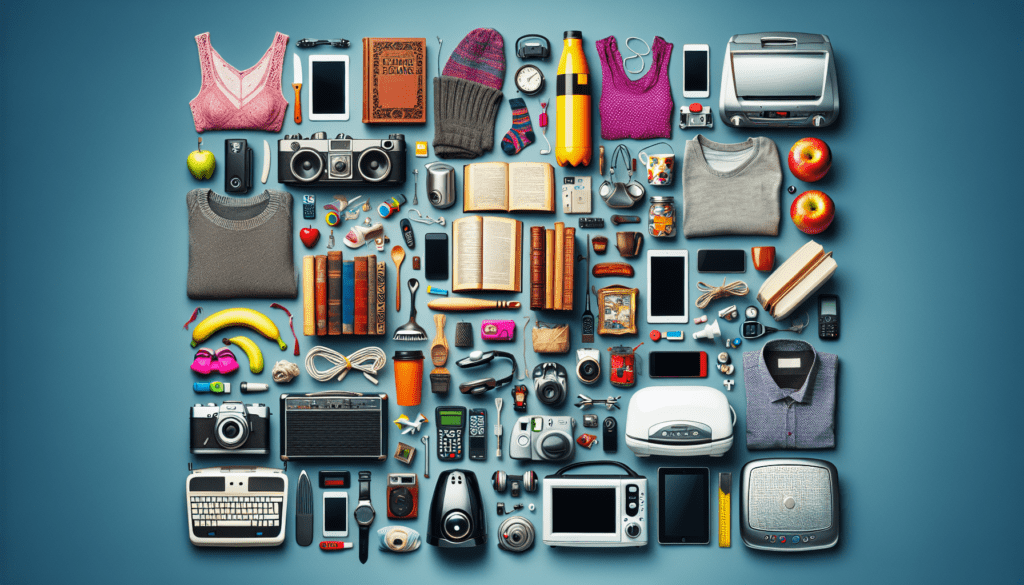Are you ready to level up your item exchange game? Look no further! In this article, we have compiled the ultimate list of the top 10 tips for exchanging items. Whether you’re a seasoned trader or just starting out, these handy tips will help you navigate the world of exchanging goods with ease. From setting clear expectations to researching market values, we’ve got you covered. So, grab a pen and paper and get ready to become a master in the art of exchanging items!
1. Research the Value of the Item
When it comes to exchanging items, the first step is to research the value of the item you have. This will help you determine a fair exchange value and ensure that you’re not being taken advantage of. There are a few key ways to research the value of an item.
1.1 Check Online Marketplaces
One of the easiest ways to gauge the value of an item is by checking online marketplaces. Platforms such as eBay, Amazon, and Etsy can give you a good idea of what similar items are selling for. Take note of the prices and condition of the items listed to get an accurate understanding of the market value.
1.2 Consider Condition and Age
When researching the value of an item, it’s important to consider the condition and age of the item. Older items may be more valuable to collectors, while items in excellent condition will typically fetch higher prices. Take into account any wear and tear, damages, or missing components when determining the value of your item.
1.3 Consult Experts or Appraisers
For particularly valuable or unique items, it may be worth consulting experts or appraisers. These professionals have extensive knowledge and experience in specific areas and can provide you with a more accurate valuation. Seek out experts in antique shops, specialized forums, or appraisal services to ensure you have a clear understanding of the item’s value.
2. Find the Right Platform or Method
Once you know the value of your item, it’s time to find the right platform or method for exchanging it. Depending on the nature of the item and your personal preferences, there are several options available to you.
2.1 Online Platforms
Online platforms such as eBay, Craigslist, or Facebook Marketplace are popular options for exchanging items. These platforms allow you to reach a wide audience and often have built-in features for secure payments and communication. Make sure to choose a platform that is relevant to the item you’re exchanging and consider factors such as fees, listing requirements, and user feedback.
2.2 Physical Marketplaces
Physical marketplaces like flea markets, garage sales, or consignment stores can be a great way to exchange items in person. These types of exchanges often provide the opportunity for negotiation and direct interaction with potential buyers or sellers. Research local markets in your area and consider the target audience and demographics to find the most suitable physical marketplace for your item.
2.3 Direct Exchanges
Sometimes the most straightforward method for exchanging items is through direct exchanges with other individuals. This can involve reaching out to friends, colleagues, or acquaintances who might be interested in your item or who have items you’re interested in. Direct exchanges can be mutually beneficial and eliminate the need for transaction fees or intermediary platforms.
2.4 Auctions or Bidding Sites
If you have a valuable item or are looking for a unique buying experience, auctions or bidding sites may be the way to go. Sites such as eBay Auctions or Heritage Auctions allow you to set a starting price and let potential buyers bid on your item. This can create excitement and competition, potentially driving up the final selling price.

3. Clearly Describe and Photograph the Item
To attract potential buyers or find the right item for exchange, it’s crucial to provide a clear and accurate description of the item you’re offering. Here are some key considerations when describing and photographing your item.
3.1 Accurate Description
Be as detailed as possible when describing your item. Include relevant information such as the brand, model, dimensions, materials used, and any notable features or flaws. Honesty is essential here to ensure that the expectations of potential buyers or other participants align with the reality of the item.
3.2 Highlight Important Details
When describing your item, make sure to highlight its unique or valuable aspects. If it’s a collectible item, mention any limited edition status, historical significance, or provenance. If it’s a functional item, emphasize its usability or any additional accessories or extras that come with it. This will help your item stand out from others and attract more interested parties.
3.3 Provide High-Quality Images
Accompanying your item description, high-quality images are crucial for potential buyers to get a visual representation of what you’re offering. Use good lighting, capture various angles, and focus on the important details. If there are any imperfections, include photos that clearly show them. Providing clear, well-photographed images will build trust and confidence in potential buyers or participants.
4. Set Fair and Realistic Expectations
When engaging in item exchanges, it’s important to set fair and realistic expectations for both parties involved. This ensures a smooth and satisfactory exchange. Consider the following factors when determining your expectations.
4.1 Understand Market Demand
Research the current market demand for the item you’re offering or seeking. If there is high demand, you may be able to set slightly higher expectations. Conversely, if the item has limited demand, you may need to be more flexible with your expectations. Understanding market demand will help you set realistic goals and negotiate effectively.
4.2 Price or Value
When setting expectations, consider the price or value of the item. Be reasonable and take into account factors such as rarity, condition, age, and the value others place on similar items. It’s important to be open to negotiation and consider the value of the item from the other party’s perspective as well.
4.3 Condition or Quality
Take the condition or quality of the item into account when setting expectations. If your item is in excellent condition, you may be able to ask for a higher-value exchange. On the other hand, if your item shows signs of wear and tear, you may need to adjust your expectations accordingly.
4.4 Timeframe for Exchange
Consider the timeframe you’re willing to wait for an exchange to take place. If you need to sell or exchange the item quickly, you may need to be more flexible with your expectations. However, if time is not a constraint, you can hold out for a more favorable exchange or price.

5. Consider Safety and Security Measures
Safety and security should always be a top priority when engaging in item exchanges, especially when dealing with strangers or unfamiliar platforms. Take these measures to protect yourself and your interests.
5.1 Buyer or Seller Reputation
Before making an exchange, do some research on the reputation of the other party involved. Check for feedback or reviews from previous exchanges, both positive and negative. This will give you a sense of their reliability and trustworthiness. Trust your instincts and avoid exchanges with individuals who have a questionable reputation.
5.2 Secure Payment Options
When conducting exchanges online, opt for secure payment options. Services such as PayPal or escrow services offer protection for both buyers and sellers by ensuring the payment is held securely until the exchange is complete. Avoid using insecure payment methods such as wire transfers or cash transactions, as these offer little to no protection in case of fraud or disputes.
5.3 Verify Legitimacy of Platforms or Participants
If you’re using an online platform for your exchange, verify the legitimacy of the platform and its participants. Look for contact information, customer support, and user reviews outside of the platform itself. Scammers often use fake platforms or profiles to trick unsuspecting individuals. Stay vigilant and verify the authenticity of the platforms and participants before engaging in an exchange.
5.4 Utilize Escrow Services (if available)
If the exchange involves a significant value or you’re concerned about the security of the transaction, consider utilizing escrow services. An escrow service acts as a neutral third party and holds the funds or items in question until both parties agree that the exchange has been completed satisfactorily. This adds an extra layer of security and ensures a fair exchange for both parties.
6. Negotiate and Communicate Effectively
Effective negotiation and communication are essential for a successful item exchange. Follow these guidelines to ensure a smooth process.
6.1 Understand the Value of the Item
Before entering into negotiations, make sure you understand the value of the item from both your perspective and the other party’s perspective. This will help you determine a fair and reasonable starting point for negotiations. Be open to compromise and willing to find a win-win solution.
6.2 Be Respectful and Professional
Maintain a respectful and professional tone throughout your communication with potential buyers or sellers. Remain open-minded, listen to the other party’s perspective, and address any concerns or questions promptly. Clear and courteous communication will help build trust and increase the likelihood of reaching a mutually beneficial agreement.
6.3 Keep Documentation of Communication
Keep a record of all communication related to the item exchange. This includes messages, email correspondence, or any other form of communication. This documentation can serve as evidence in case of disputes or misunderstandings. It’s always better to have a clear record of agreements and conversations to refer back to if needed.
6.4 Collaborate to Reach a Win-Win Agreement
Collaboration is key to reaching a win-win agreement in an item exchange. Engage in open discussions, consider the needs and wants of both parties, and be willing to compromise. By working together, you can create a mutually beneficial exchange that satisfies both parties involved.

7. Consider Additional Costs or Requirements
In addition to the item itself, there may be additional costs or requirements to consider during the exchange process. Take these factors into account to avoid unexpected surprises.
7.1 Shipping or Delivery Expenses
If the exchange involves shipping or delivery, factor in the associated costs. Research shipping rates, packaging materials, and any additional fees that may apply. Discuss shipping arrangements with the other party and agree on who will be responsible for these expenses.
7.2 Insurance Coverage
Consider whether you need insurance coverage for the item during the exchange process. If the item is valuable or fragile, it’s wise to invest in insurance to protect against loss or damage. Consult with your insurance provider to ensure you have adequate coverage.
7.3 Packaging or Handling Requirements
Certain items may require special packaging or handling to ensure their safety during the exchange. If this is the case, make sure to communicate these requirements clearly with the other party. Discuss who will be responsible for providing the necessary packaging materials or handling arrangements.
7.4 Customs or Legal Compliance (if applicable)
If the exchange involves international shipping or falls under specific legal regulations, ensure that you comply with all customs or legal requirements. Research customs duties, import/export restrictions, or any other applicable laws to avoid any legal repercussions or delays in the exchange process.
8. Learn about Return Policies and Guarantees
Before finalizing an item exchange, it’s important to familiarize yourself with the return policies and guarantees associated with the platform or method you’re using. This will protect you in case the item doesn’t meet your expectations or there are unforeseen issues.
8.1 Read Return Policy and Guarantee Terms
Take the time to thoroughly read and understand the return policy and guarantee terms of the platform or method you’re using. Different platforms have different policies, timelines, and requirements for returns or guarantees. Make sure you agree with and can comply with these terms before proceeding with the exchange.
8.2 Understand Eligibility and Conditions
Check the eligibility criteria and any specific conditions that must be met to qualify for a return or guarantee on the item. This may include things like maintaining the original packaging, providing proof of purchase, or adhering to a specific timeline for returns. Understanding these requirements will help you navigate the exchange process smoothly.
8.3 Keep Proof of Purchase or Exchange Agreement
Keep a copy of the proof of purchase or exchange agreement for the item. This can be in the form of a receipt, email confirmation, or any other documentation that outlines the details of the exchange. Having this evidence will be important if any issues or disputes arise in the future.

9. Build a Network and Explore Community Exchanges
Building a network and exploring community exchanges can broaden your opportunities for item exchanges and create a sense of community. Consider the following options to expand your exchange possibilities.
9.1 Join Online Communities or Forums
Joining online communities or forums that are relevant to the items you’re interested in can connect you with like-minded individuals. These communities often have dedicated sections for buying, selling, and exchanging items. Engage in discussions, contribute valuable insights, and establish connections with other members to increase your chances of finding suitable exchanges.
9.2 Attend Local Swap Meets or Events
Local swap meets or events provide the perfect opportunity to engage with others who share similar interests. These events bring together a wide variety of individuals who are open to exchanging or bartering items. Attend these events, strike up conversations with fellow participants, and explore potential exchanges. You may discover unique items or build valuable relationships within your local community.
9.3 Participate in Bartering or Trading Circles
Bartering or trading circles are organized groups where members exchange items without using traditional currency. By participating in these circles, you can connect with individuals who are willing to exchange items directly, based on mutual interest and need. These circles can provide a more personal and meaningful exchange experience.
10. Leave Feedback and Reviews
Once the item exchange is complete, it’s important to leave feedback and reviews to help others make informed decisions. Your experience and insights can be valuable to future buyers or sellers.
10.1 Share Your Experience
Share your experience with the exchange process, including interactions with the other party and any challenges or positive aspects you encountered. Be honest and provide a balanced perspective. Sharing your experience will help others decide whether to engage with the same individual or platform in the future.
10.2 Provide Constructive Criticism
If you encountered any issues or areas for improvement during the exchange process, provide constructive criticism in your feedback or review. This feedback can help the other party or platform identify areas that need attention and may lead to improvements in future exchanges.
10.3 Help Others Make Informed Decisions
Think about the information you found valuable when researching the item or platform. Consider including that information in your feedback or review to help others make more informed decisions. By sharing your insights, you can contribute to a more transparent and trustworthy exchange community.
In conclusion, successfully exchanging items requires careful research, effective communication, and consideration of various factors such as value, platform, and safety. By following these top 10 tips, you can navigate the exchange process with confidence and create positive experiences for both parties involved. Whether you’re exchanging items online or in person, these guidelines will help you make informed decisions and find mutually beneficial exchanges.



